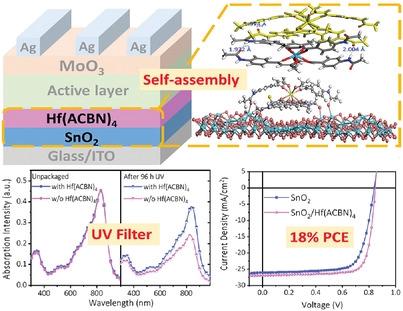当前位置:
X-MOL 学术
›
Adv. Energy Mater.
›
论文详情
Our official English website, www.x-mol.net, welcomes your
feedback! (Note: you will need to create a separate account there.)
Self-Assembly Metal Chelate as Ultraviolet Filterable Interface Layer for Efficient Organic Solar Cells
Advanced Energy Materials ( IF 24.4 ) Pub Date : 2022-06-30 , DOI: 10.1002/aenm.202201306 Runnan Yu 1 , Rui Shi 1 , Hao Liu 1, 2 , Guangzheng Wu 1 , Zongwen Ma 1 , Huaizhi Gao 1 , Zhangwei He 1 , Zhan'ao Tan 1
Advanced Energy Materials ( IF 24.4 ) Pub Date : 2022-06-30 , DOI: 10.1002/aenm.202201306 Runnan Yu 1 , Rui Shi 1 , Hao Liu 1, 2 , Guangzheng Wu 1 , Zongwen Ma 1 , Huaizhi Gao 1 , Zhangwei He 1 , Zhan'ao Tan 1
Affiliation

|
Interface engineering plays a vital role in the further improvement of efficiency and stability for organic solar cells (OSCs). Herein, a self-assembly metal chelate based on hafnium and a designed ligand, N-(4-(3-oxobutanoyl)phenyl)acetamide (ACBN) is applied as both interfacial modification layer and UV-light filter in OSCs. The strong hydrogen-bond induced intermolecular interaction enables Hf(ACBN)4 with the prerequisite of adequate solvent resistance to work as an electron transport layer (ETL) in the inverted OSCs. The self-assembly behavior of Hf(ACBN)4 on the SnO2 film surface via constructing compact coordination structure has been verified via systematic theory calculations. In addition to optimizing the energy level alignment, the Hf(ACBN)4 modification effectively passivates the surface defect of SnO2 films for less surface charge recombination and a more efficient charge collection process. Thus, the OSCs with Hf(ACBN)4 layer yield a maximum PCE of 18.1%, better than that based on the bare SnO2 layer. Moreover, beneficial from the reduced oxygen vacancies via coordination effect and the UV-light filter function of Hf(ACBN)4, the OSCs based on SnO2/ Hf(ACBN)4 composite ETL exhibit preferable stabilities under UV-light irradiation or continuous operational conditions.
中文翻译:

自组装金属螯合物作为高效有机太阳能电池的紫外线可过滤界面层
界面工程在进一步提高有机太阳能电池(OSC)的效率和稳定性方面发挥着至关重要的作用。在此,基于铪和设计的配体 N-(4-(3-氧代丁酰基)苯基)乙酰胺 (ACBN) 的自组装金属螯合物在 OSC 中用作界面改性层和紫外光过滤器。强氢键诱导的分子间相互作用使 Hf(ACBN) 4在具有足够耐溶剂性的前提下能够在倒置 OSC 中用作电子传输层 (ETL)。通过系统的理论计算验证了Hf(ACBN) 4通过构建致密的配位结构在SnO 2薄膜表面的自组装行为。除了优化能级对齐之外,Hf(ACBN)4改性有效地钝化了SnO 2薄膜的表面缺陷,从而减少了表面电荷复合和更有效的电荷收集过程。因此,具有 Hf(ACBN) 4层的 OSC 产生的最大 PCE 为 18.1%,优于基于裸 SnO 2层的 OSC。此外,得益于通过配位效应降低氧空位和 Hf(ACBN) 4的紫外光过滤功能,基于 SnO 2 / Hf(ACBN) 4复合 ETL 的 OSC 在紫外光照射或连续运行下表现出较好的稳定性条件。
更新日期:2022-06-30
中文翻译:

自组装金属螯合物作为高效有机太阳能电池的紫外线可过滤界面层
界面工程在进一步提高有机太阳能电池(OSC)的效率和稳定性方面发挥着至关重要的作用。在此,基于铪和设计的配体 N-(4-(3-氧代丁酰基)苯基)乙酰胺 (ACBN) 的自组装金属螯合物在 OSC 中用作界面改性层和紫外光过滤器。强氢键诱导的分子间相互作用使 Hf(ACBN) 4在具有足够耐溶剂性的前提下能够在倒置 OSC 中用作电子传输层 (ETL)。通过系统的理论计算验证了Hf(ACBN) 4通过构建致密的配位结构在SnO 2薄膜表面的自组装行为。除了优化能级对齐之外,Hf(ACBN)4改性有效地钝化了SnO 2薄膜的表面缺陷,从而减少了表面电荷复合和更有效的电荷收集过程。因此,具有 Hf(ACBN) 4层的 OSC 产生的最大 PCE 为 18.1%,优于基于裸 SnO 2层的 OSC。此外,得益于通过配位效应降低氧空位和 Hf(ACBN) 4的紫外光过滤功能,基于 SnO 2 / Hf(ACBN) 4复合 ETL 的 OSC 在紫外光照射或连续运行下表现出较好的稳定性条件。

































 京公网安备 11010802027423号
京公网安备 11010802027423号